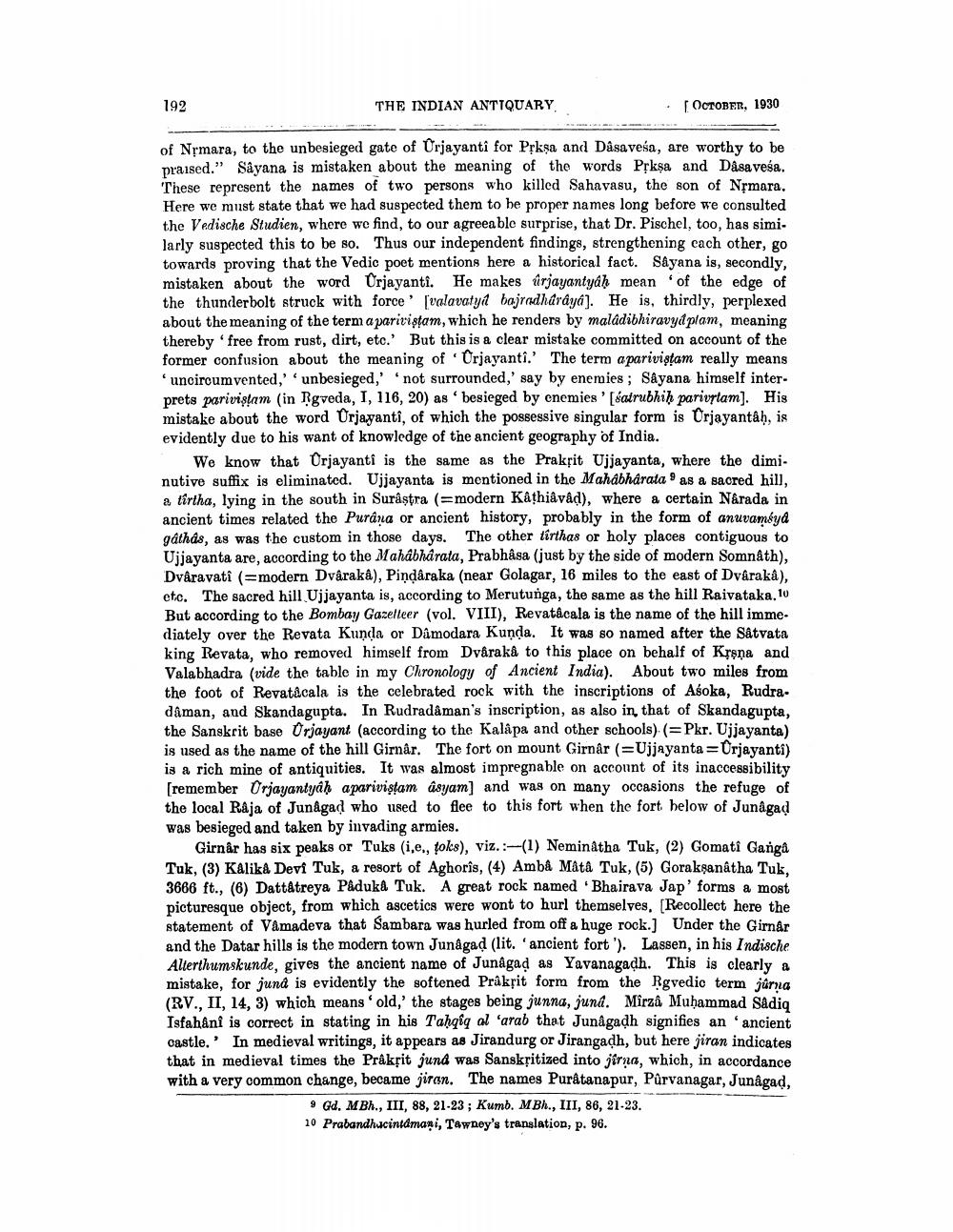________________
192
THE INDIAN ANTIQUARY
·
OCTOBER, 1930
of Nrmara, to the unbesieged gate of Urjayanti for Prkşa and Dasaveša, are worthy to be praised.” Sayana is mistaken about the meaning of the words Ppksa and Dåsaveśa. These represent the names of two persons who killed Sahavasu, the son of NȚmara. Here we must state that we had suspected them to be proper names long before we consulted the Vedische Studien, where we find, to our agreeable surprise, that Dr. Pischel, too, has simi. larly suspected this to be so. Thus our independent findings, strengthening cach other, go towards proving that the Vedic poet mentions here a historical fact. Sayana is, secondly, mistaken about the word Orjayanti. He makes ürjayantyah mean of the edge of the thunderbolt struck with force' [valavatyt bajradhardya). He is, thirdly, perplexed about the meaning of the term a pariristam, which he renders by maladibhiravyd plam, meaning thereby free from rust, dirt, etc.' But this is a clear mistake committed on account of the former confusion about the meaning of Orjayanti.' The term aparivistam really means 'uncircumvented,'' unbesieged, not surrounded,' say by enemies; Sayana himself interprets parivistam (in Rgveda, 1, 116, 20) as 'besieged by enemies 'Satrubhih parivslam). His mistake about the word Urjayanti, of which the possessive singular form is Orjayantâh, is evidently due to his want of knowledge of the ancient geography of India.
We know that Orjayanti is the same as the Prakrit Ujjayanta, where the diminutive suffix is eliminated. Ujjayanta is mentioned in the Mahabharata as a sacred hill, a tirtha, lying in the south in Surâştra (=modern Kâthiâvâd), where a certain Närada in ancient times related the Purana or ancient history, probably in the form of anuvaméya gáthas, as was the custom in those days. The other tirthas or holy places contiguous to Ujjayanta are, according to the Mahabharata, Prabhâsa (just by the side of modern Somnath), Dvâravatî (=modern Dvâraka), Pindaraka (near Golagar, 16 miles to the east of Dvaraka), etc. The sacred hill Ujjayanta is, according to Merutunga, the same as the hill Raivataka.10 But according to the Bombay Gazelleer (vol. VIII), Revat&cala is the name of the hill immediately over the Revata Kunda or Damodara Kunda. It was so named after the Såtvata king Revata, who removed himself from Dvårakå to this place on behalf of Krsna and Valabhadra (vide the table in my Chronology of Ancient India). About two miles from the foot of Revatacala is the celebrated rock with the inscriptions of Asoka, Rudra. daman, and Skandagupta. In Rudradâman's inscription, as also in that of Skandagupta, the Sanskrit base Orjayant (according to the Kalapa and other schools) (=Pkr. Ujjayanta) is used as the name of the hill Girnar. The fort on mount Girnar (=Ujjayanta Orjayanti) is a rich mine of antiquities. It was almost impregnable on account of its inaccessibility (remember Urjayantyah aparivistam asyam] and was on many occasions the refuge of the local Raja of Junagad who used to flee to this fort when the fort below of Junagad was besieged and taken by invading armies.
Girnår has six peaks or Tuks (i,e, toks), viz. :-(1) Neminatha Tuk, (2) Gomati Gangå Tuk. (3) KAlika Devi Tuk, a resort of Aghoris, (4) Amba Mata Tuk, (5) Gorakşanatha Tuk. 3666 ft., (6) Dattatreya Paduka Tuk. A great rock named Bhairava Jap' forms a most picturesque object, from which ascetics were wont to hurl themselves. (Recollect here the statement of Vamadeva that Sambara was hurled from off a huge rock.) Under the Girnar and the Datar hills is the modern town Junagad (lit. 'ancient fort '). Lassen, in his Indische Alterthumskunde, gives the ancient name of Junagad as Yavanagadh. This is clearly a mistake, for jund is evidently the softened Prakțit form from the Rgvedio term júrna (RV., II, 14, 3) which means old,' the stages being junna, jund. Mirza Muhammad Sadiq Isfahání is correct in stating in his Tahqiq al 'arab that Junagadh signifies an ancient Castle.' In medieval writings, it appears as Jirandurg or Jirangadh, but here jiran indicates that in medieval times the Prakpit jund was Sanskřitized into jirşa, which, in accordance with a very common change, became jiran. The names Puratanapur, Purvanagar, Junagad.
. Gd, MB., III, 88, 21-23; Kumb. MBh., III, 86, 21-23. 10 Prabandhucintamani, Tawney's translation, p. 96.




